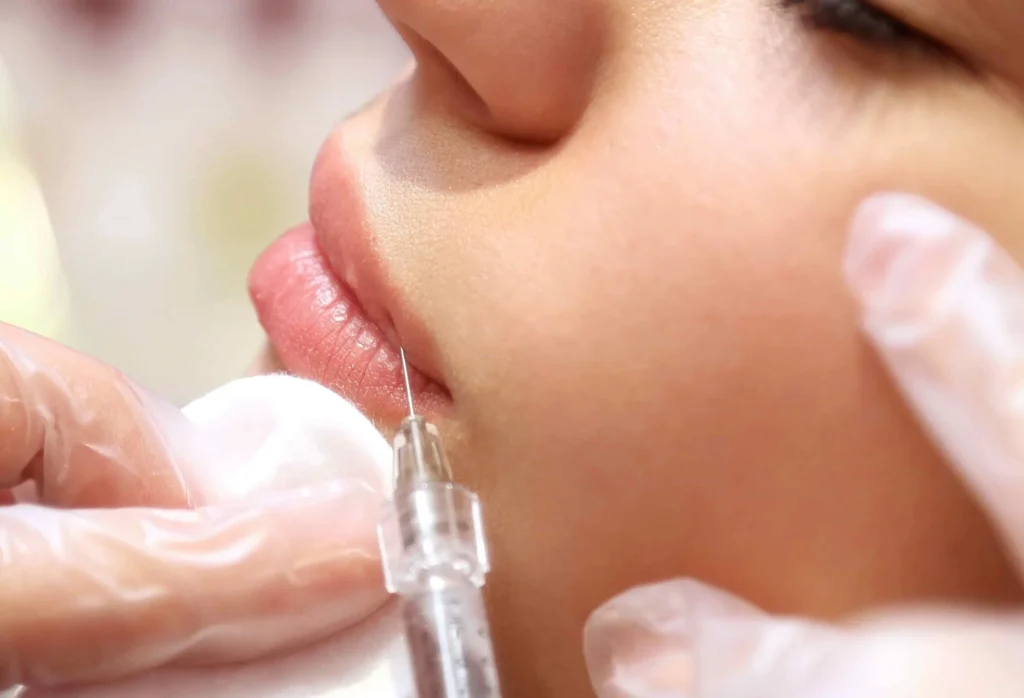Beauty Blog
Lip Filler Swelling Stages
Noticeable swelling, which creates physical and aesthetic discomfort for many patients, often accompanies lip augmentation with dermal fillers. This is, however, an entirely natural bodily reaction to the intervention.
Before the procedure, it is crucial to study the specifics of filler implementation and potential consequences; and learn about the lip filler swelling timeline.
How Lip Fillers Work
2 main factors cause swelling of the lips:
- tissue reaction to injury by cosmetic needles/cannulae;
- effects of hyaluronic fillers.
Lip augmentation is achieved by injecting HA-based dermal fillers into the lips. Those injectables replace lost (or missing) collagen and fat, smooth lines and wrinkles, and make lips fuller.
Hyaluronic acid is a large polysaccharide molecule with unique properties to bind and hold water molecules, with a volume 1000 times greater than its own. This is the main principle of the fillers action: lip enlargement occurs due to water molecules’ deposition (retention) and controlled swelling.
The most prominent inflammation and swelling occur in the first days after the filler injection. After this, the lips gain neat, attractive, and desirable plumpness.
Why Does Lip Filler Swelling Happen After the Procedure?
Swelling after lip augmentation is typical; it’s the body’s reaction to tissue injury and drug administration. Even a minimal amount of the highest quality filler and ultra-thin needles do not guarantee the absence of swelling of soft tissues.
Lip swelling after dermal filler injection may not lead to significant discomfort and will not differ from the subsequent effect. The degree of swelling depends on the body’s reactivity and the amount and quality of the injected filler. Sometimes, swelling can be quite significant and cause pain.
Below are the factors that lead to swelling and the formation of lumps from lip fillers:
- Injection Site Trauma
The injection process is one of the most common reasons for lumps or bumps after lip fillers. Waiting for the swollen and bruised skin to heal before massaging the area is recommended. If a lump forms because of trauma, it usually resolves within a week.
- Lip Size
The size of the lips is also a factor that can increase the risk of lumps after lip fillers. Individuals with smaller lips are more prone to developing swelling, as more product is required to enhance lip volume.
- First-Time Filler Experience
Newcomers to lip fillers are more likely to develop swelling after lip filler administration. Using over 1 mL of the product on the lips can also increase the chance of lumps.
- Product Consistency
The product’s composition is another cause for lumps to form after lip fillers. Modern fillers are stiffer, with higher G prime ratings. This quality can enhance the lips’ shape and increase the likelihood of lumpy lips.
Products like Restylane and Juvederm have high G prime ratings, making them more susceptible to clumping.
- Poor Injection Technique
The injector’s inadequate skill level or experience can lead to larger lip filler clusters, creating lumps in the lips.
- Muscle Movements
Lip dynamics and muscle movements can also affect how the filler settles, causing it to cluster in certain areas and form abnormal lumps.
Severe and/or long-lasting swelling, accompanied by pain and redness, indicates pathological reactions. The following problems cause pathological swelling of the lips:
- Injury to a large vessel during needle insertion (swelling with hematoma formation);
- Incorrect calculation of the required volume of filler (excess hyaluronic acid cannot be distributed in the middle of the limited volume of lip tissues);10–1410–14
- Infection (complications may occur when aseptic measures are violated during filler injection);
- Allergy to the filler (the patient’s body does not perceive hyaluronic acid, so swelling may be accompanied by itching, burning, and hyperemia).
Severe swelling of the lips and tissues around the mouth immediately after the procedure indicates an allergy to the local anesthetic in the filler. In such a situation, a doctor must provide emergency medical assistance.
Lip Filler Swelling Stages
A few minor side effects occur when using drugs based on low molecular weight hyaluronic acid. Concentrated gels with a high density often provoke severe swelling.
1 Week Lip Filler Swelling Stages:
On day 1, appearance of inflammation. Mild to moderate lip swelling can occur within minutes after the injection. Later, the upper lip may become much larger than the lower lip.
Sensitivity of the lips, tenderness, and discomfort are most common in the first couple of days. This is also the period when there’s the most significant risk of developing cold sores.
On lip filler swelling day 2, inflammation is most severe and intense.
The patient may have significant swelling, bruising, and bumps; reassure them that there is no need to worry – inflammation is just a natural effect of trauma after injections.
During the lip filler swelling day 3, the lips’ swelling finally decreases. On day 4, it becomes more comfortable for the patient to eat and talk. Over time, the lips’ appearance and feel will improve.
After one week, the patient sees the final results of the lip augmentation. Swelling fades, and lips look plump.
At the longest, it can take two weeks for the swelling to disappear completely. However, most patients finish the lip filler healing process by day 5.
How to Reduce Swelling
There are a few recommendations for the patient before the appointment to reduce post-treatment swelling:
- Avoid blood thinners such as Advil, Motrin, Aleve, and Naproxen 10-14 days before getting filler.
- Avoid supplements that can increase the risk of bleeding and swelling, such as fish oil, vitamin E, garlic, and ginkgo Biloba. You should also avoid these for 10 to 14 days before your procedure.
- No alcohol at least 48 hours before getting filler, as it can increase the risk of bruising and swelling.
- Take a third-generation antihistamine several days before the treatment.
- Use arnica, which can lessen inflammation and bruising. This supplement is available in topical or oral forms; patients can use both.
For quick and high-quality recovery of the lips after contour plastic surgery, give your patient the following set of rules:
- Apply cold compresses to the swelling area in the first two days after the procedure.
- Minimize mechanical effects (do not knead the fillers with fingers, avoid passionate kisses, and carefully brush teeth).
- Apply tissue repair creams/ointments (only recommended by the doctor).
- Before going outside, apply sunscreen with SPF 30+ to the injured area.
- Avoid hot baths and saunas, as thermal exposure slows healing.
- Refuse or limit smoking as much as possible until the swelling disappears.
Many patients try to hide swelling after lip augmentation using makeup, which is not recommended. Chemical components of lipsticks/glosses irritate damaged skin, so this masking can also interfere with regenerative processes.
Conclusion
Lip augmentation with dermal fillers is a popular cosmetic procedure that often results in noticeable swelling of the lips. While this is a natural response to the intervention, it can cause physical and aesthetic discomfort for many patients.
However, the severity of swelling depends on several factors, such as injection site trauma, the size of the lips, product consistency, first-time filler experience, poor injection technique, and muscle movements. For medical professionals, it is essential to understand the specifics of filler implementation, the possible consequences, and the lip filler swelling timeline.
Doctors must inform their patients about the lip filler swelling timeline and possible side effects before the procedure. Patients should also be aware of the symptoms of pathological swelling, such as pain, redness, and allergy, and seek emergency medical attention if necessary.
If the injections are performed correctly, and the patient has no intolerances to the filler’s components, swelling usually disappears within 4-14 days. By understanding the lip filler swelling stages and factors that contribute to it, you can provide your patients with a satisfactory outcome and positive experience.
FAQ
How long does it take for lip filler swelling to go down?
The swelling after the filler injection is the worst on the first day, particularly in the morning. However, it should fade within 2–3 days after the lip filler treatment and, within two weeks, should subside completely.
Do lip fillers look bigger at first?
Right after the filler administration, lips look more significant than the end result due to swelling. This effect will fade with the lip filler healing process day by day.
Are lips still swollen five days after filler?
Usually, the healing after the lip filler injection lasts up to two weeks. If, after this time, the lips are still swollen, the patient needs a consultation with the doctor.

